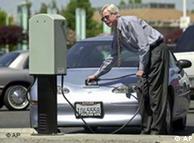New report from The Brookings Institute: Transportation and Climate Change: The Perfect Storm
(Source: The Brookings Institute)![]()
As Vice President Biden’s Earth Day speech at a Washington area subway station makes clear, the connections between transportation and climate change are undeniable. Therefore, exactly how our metropolitan areas grow—and what type of transportation people use to get from place to place—will have a great impact not only on the economy, but also on global environmental sustainability.
Brookings fellow, Robert Puentes, argues in a new report that we need to change, in a systemic way, how we think about, design and implement transportation policies. Beyond more fuel efficient and alternatively powered vehicles, we need to act to reduce demand for driving by linking housing, land use, and economic development.
Report Excerpts:
Transportation is the single largest contributor to the nation’s carbon footprint, causing more damage than industry, homes or commercial buildings. More than four-fifths of transportation emissions come from the tailpipes of our cars, trucks and buses.
Three factors affect the amount of carbon released into the air from transportation: the type of fuel we use, the fuel efficiency of the automobiles we drive and the amount of driving we do. Some improvements are being made on the first two legs of this stool with the push for hybrid/electric vehicles and tighter fuel economy standards.
Progress is much slower on the third leg: curbing the demand to drive. Though driving is down now because of our economic malaise, studies show that even small increases will spew out so much carbon that they will wipe out the benefits of fuel-efficient cars and the expansion of clean-fuel alternatives. Take the Washington metropolitan area. This region is projected to grow from 7.6 million people in 2000 to 10.6 million in 2030. Employment could grow from 4.4 million to 6.4 million workers, and non-residential development from 3.6 billion square feet to 5.2 billion. That means about 60 percent of the buildings that will be here in 2030 will have been built after 2000.
How we accommodate this growing population and economy – whether we break the pattern of “sprawl as usual” – will significantly influence whether we secure our energy independence and forge solutions to global warming and climate change.
Click here to read the entire report.








